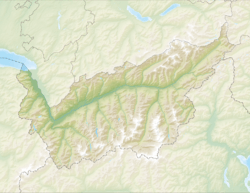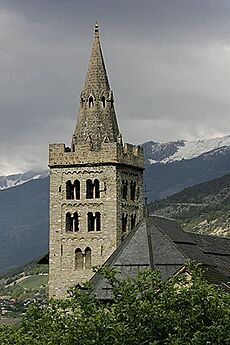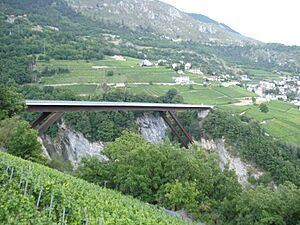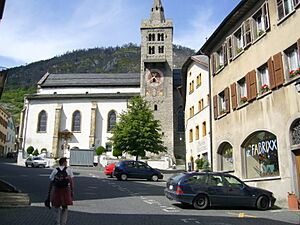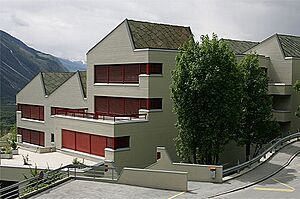Leuk facts for kids
Quick facts for kids
Leuk
|
||
|---|---|---|
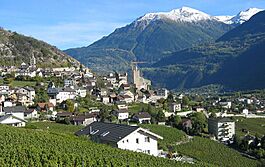 |
||
|
||
| Country | Switzerland | |
| Canton | Valais | |
| District | Leuk | |
| Area | ||
| • Total | 55.15 km2 (21.29 sq mi) | |
| Elevation | 731 m (2,398 ft) | |
| Population
(Dec 2020 )
|
||
| • Total | 3,991 | |
| • Density | 72.366/km2 (187.43/sq mi) | |
| Postal code |
3953
|
|
| Localities | Briannen, Gampinen, Leuk-Stadt, Pfyn, Pletschen, St. Josephsheim, Susten | |
| Surrounded by | Agarn, Albinen, Bratsch, Chandolin, Erschmatt, Guttet-Feschel, Inden, Salgesch, Turtmann, Varen | |
| Twin towns | Münchwilen, Thurgau (Switzerland) | |
Leuk (also known as Loèche-Ville in French) is a town in the Valais canton of Switzerland. It's a "municipality," which is like a local government area. In 2013, another town called Erschmatt joined Leuk.
Leuk has always been important because it controls the way to the Gemmi Pass. This pass is a mountain route that was used even in Roman times. Just north of Leuk, you'll find the famous Leukerbad thermal baths, which are hot springs. Leuk is also the main town of its district.
Did you know Leuk is home to a special Swiss system called Onyx? It's used for gathering signals intelligence, which means collecting information from electronic signals.
Contents
Leuk's Long History
Leuk is a very old place! It was first mentioned way back in the year 515 as villa de Leuca.
Ancient Times and Early Settlements
People lived in Leuk even before the Romans arrived. Archeologists have found graves from the La Tène culture, which was an ancient Celtic group. These graves contained interesting items like pins, brooches, and belt hooks.
In the 6th century, Leuk was part of the Kingdom of Burgundy. The king, Sigismund, gave it to a monastery called the Abbey of Saint-Maurice. Over time, the local people, who were a mix of Roman and Celtic, started speaking German. This happened because of groups like the Alamanni who moved into the area. But even in the 1300s, many people in Leuk still spoke a Roman language.
Churches and Buildings Through the Ages
Leuk's first church was built around the 6th or 7th century, possibly on the site of an old Roman building. This church was rebuilt several times. The tall, Romanesque bell tower you see today is from a church built in the 11th or 12th century.
The main church now, St. Stephan's Church, was built in the Gothic style by Ulrich Ruffiner. It was finished in 1494. Inside, there's a special room called a charnel house where bones were kept. In 1982, 26 old statues were found there, hidden under a lot of bones! One of these is a beautiful Pietà statue from the 1300s.
Besides St. Stephan's, Leuk has other churches. There's a chapel at Thel and the Ringacker chapel, built in the late 1600s over a plague cemetery. A special Marian shrine, which once had a hermit living nearby, is considered one of the most important Baroque buildings in the Valais region.
Leuk Under the Bishops
In the Middle Ages, Leuk changed hands many times. But in 1138, it finally came under the control of the Bishop of Sion. The bishops helped Leuk grow by giving it special rights. For example, in 1209, Leuk got the right to have its own weights and measures for trade.
They also built a hospital in 1285 and a large warehouse in 1310. This warehouse was important because Leuk was on a major trade route between northern Italy and other European markets. People in Leuk even had a team of "teamsters" who provided extra animals to help pull wagons over the mountains.
The Bishop's Castle and the Viztumsturm (a tower) were built by the bishop's local leaders. In the 1400s, Leuk created its own laws, which were updated in 1563.
Growing into an Independent Town
As the old feudal system changed, Leuk became more independent. New families became important, and the town grew with elegant homes and a new church. Bridges were built over the Dala gorge and the Feschel gorge, making it easier to travel.
The deep gorges and the Rhone River to the south made Leuk a naturally strong place for defense. There were several battles here. In 1296, the bishop's troops won a victory against local nobles. In 1386, Leuk stopped an army from Savoy by destroying the Dala bridge. In 1415, during a war, the Bishop's Castle and the Viztumsturm were destroyed.
The current Gothic-style town hall was built in 1541 on the ruins of the Viztumsturm. In 1799, during fighting against the French, Leuk was burned but avoided more serious damage.
Leuk's Economy and Modern Changes
For a long time, Leuk's economy relied on transporting goods, raising animals in the mountains, farming, and growing grapes for wine. They also used to dig gravel from the Rhone River until the 1970s.
In 1908, a large aluminum processing plant opened nearby, creating many jobs for people from Leuk. A railway line to Leukerbad opened in 1915, though it later became a bus route in 1967. In 2005, the train station in Susten was rebuilt.
Today, Leuk is still a central place for the region. It's a hub for education, law, and services. It's also a major international telecommunications center thanks to the large antennas of the International Teleport Switzerland AG. These antennas help connect people across continents! Near these antennas are also the antennas for the Swiss military's Onyx system, which gathers electronic intelligence.
In 1999, a foundation was created to restore the Bishop's Castle. As part of this work, one of the medieval towers was given a modern glass dome designed by the famous architect Mario Botta.
Leuk's Geography
Leuk covers an area of about 44.1 square kilometers (about 17 square miles). Almost half of this area is covered by forests (48.9%), and about 19.6% is used for farming. About 4.8% of the land has buildings or roads, and the rest is unproductive land.
The town is located on the right side of the Rhone River, between the Dala gorge and the Feschelbach river. Leuk is surrounded by beautiful vineyards. The municipality includes the main village of Leuk-Stadt, the castle, the village of Susten (on the left bank of the Rhone), and smaller areas like Brianen, Feithieren, Gampinen, and Pfyn.
Leuk's Coat of Arms
The blazon of Leuk's coat of arms shows a red shield with a silver griffin (a mythical creature with the body of a lion and the head and wings of an eagle). The griffin is standing on its hind legs, facing away, and holding a silver sword.
People of Leuk
Leuk has a population of about 3,376 people. About 11% of the people living in Leuk are foreign nationals. Over the last ten years, the population has grown a little.
Most people in Leuk (about 92.8%) speak German as their main language. Albanian is the second most common language, followed by French.
In 2008, about 49.6% of the population was male and 50.4% was female. Many people (about 48.1%) were born in Leuk and still live there.
Population Changes Over Time
Here's how Leuk's population has changed over the years:

Important Heritage Sites
Several places in Leuk are considered very important Swiss heritage sites. These include:
- The Dalaturm (Dala Tower)
- The Church of St. Stephan
- The Rathaus (Town Council House)
- The Ringacker Chapel of Mariä Empfängnis with its Hermitage
- Zen-Ruffinen Castle
The entire small town of Leuk and the village of Erschmatt are also part of the Inventory of Swiss Heritage Sites.
Economy and Jobs
In 2010, Leuk had a low unemployment rate of 2.2%. Many people work in different areas:
- Primary sector: About 148 people work in farming, forestry, or similar jobs.
- Secondary sector: About 218 people work in manufacturing or construction.
- Tertiary sector: The largest group, about 850 people, work in services like sales, transportation, hotels, restaurants, finance, education, and healthcare.
Leuk is a place where more people leave to work in other towns than come into Leuk for work. About 20.9% of working people use public transportation to get to work, and 55.8% use a private car.
Religion in Leuk
According to the 2000 census, most people in Leuk (about 84.6%) are Roman Catholic. About 4.7% belong to the Swiss Reformed Church. There are also smaller numbers of people who are Orthodox Christian, Christian Catholic, or other Christian faiths. About 4.2% of the population is Islamic. A small number of people belong to no church or are agnostic or atheist.
Education in Leuk
In Leuk, about 34.2% of the population has finished upper secondary education (like high school), and 6.4% have completed higher education (like university).
During the 2010–2011 school year, there were 438 students in Leuk's schools.
- Kindergarten: There were 63 kindergarten students.
- Primary School: There were 258 students in primary school (grades 1-6).
- Secondary School: There were 180 students in lower secondary school (grades 7-9).
Some students from Leuk go to school in other towns, and some students from other towns come to school in Leuk.
Notable People from Leuk
- Franz Xaver, Baron von Werra (1914–1941): A German World War II fighter pilot who was famous for escaping capture in Britain and returning to Germany.
- Rabea Grand (born 1984): A retired alpine skier who became the Swiss national champion in giant slalom in 2009.
Images for kids
See also
 In Spanish: Leuk para niños
In Spanish: Leuk para niños




